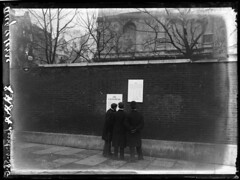
| Chapter Name | Chapter Title |
|---|---|
| Chapter I | The Two Poets of Saffron Park |
| Chapter II | The Secret of Gabriel Syme |
| Chapter III | The Man Who Was Thursday |
| Chapter VI | The Tale of a Detective |
| Chapter V | The Feast of Fear |
| Chapter VI | The Exposure |
| Chapter VII | The Unaccountable Conduct of Professor de Worms |
| Chapter VIII | The Professor Explains |
| Chapter IX | The Man in Spectacles |
| Chapter X | The Duel |
| Chapter XI | The Criminals Chase the Police |
| Chapter XII | The Earth in Anarchy |
| Chapter XIII | The Pursuit of the President |
| Chapter XIV | The Six Philosophers |
| Chapter XV | The Accuser |
| Copyright © | G. K. Chesterton, 1908 |
|---|---|
| By the same author | There are no more works at Badosa.com |
| Date of publication | November 2004 |
| Collection | Worldwide Classics |
| Permalink | https://badosa.com/n216 |
Creo que GK Chesterton es uno de los pensadores más completos de los últimos siglos y, por lejos, el más lúcido del siglo XX.
Sin duda, Chesterton es un ensayista y pensador inteligente, pero lo que hace que sus ensayos tengan ese atractivo especial son, ante todo, esas gemas brillantes que los enriquecen: me refiero a sus paradojas desopilantes.
En el siglo XX, existen ensayistas más demoledores y rigurosos (como Bertrand Russell o George Santayana) que Chesterton, básicamente porque no mezclaban poesía y filosofía en la argumentación de sus textos, lo cual los hace más rigurosos y científicos, pero menos divertidos que los del vecino de Beaconsfield.
Comoquiera que un ensayo debe ser inteligente y divertido, Chesterton sí podría ocupar el nº 1 como maestro en el ensayo genérico, pero no como el nº 1 en ensayo filosófico, que ocuparía seguramente Russell o Santayana, ya que Chesterton dio muestras de ser más artista que filósofo (su prolijidad, sus ganas de "pintar el pueblo todo de rojo", es la razón, como se opina en la biografía de Ward). De hecho, su catolicismo le hizo demasiado conservador con respecto al sexo (del que en sus ensayos no se habla, si no es a la manera de San Pablo), al valor social de la mujer (en casa cuidando hijos), a la ciencia (v.g. criticó a Einstein dando por supuesto que la relatividad era un despropósito, sin justificar sus argumentos por la vía científica, sólo con poesía y teologia apologéticas; también luchó por demoler los cimientos del darwinismo con poesía, lo cual es poco riguroso, filosóficamene hablando), al Arte (criticó el verso libre con vehemencia en sus ensayos, cuando, paradójicamente, siempre sintió un amor whitmaniano; despreciaba a Picasso y a la vanguardia; nunca los entendió, ni pretendió hacerlo: en este sentido, Santayana como esteta fue mucho más apreciativo y un crítico más racional y medido; véase su The Sense of Beauty, o The Life of Reason para ello).
Besides sending your opinion about this work, you can add a photo (or more than one) to this page in three simple steps:
Find a photo related with this text at Flickr and, there, add the following tag: (machine tag)
To tag photos you must be a member of Flickr (don’t worry, the basic service is free).
Choose photos taken by yourself or from The Commons. You may need special privileges to tag photos if they are not your own. If the photo wasn’t taken by you and it is not from The Commons, please ask permission to the author or check that the license authorizes this use.
Once tagged, check that the new tag is publicly available (it may take some minutes) clicking the following link till your photo is shown: show photos 
Even though Badosa.com does not display the identity of the person who added a photo, this action is not anonymous (tags are linked to the user who added them at Flickr). Badosa.com reserves the right to remove inappropriate photos. If you find a photo that does not really illustrate the work or whose license does not allow its use, let us know.
If you added a photo (for example, testing this service) that is not really related with this work, you can remove it deleting the machine tag at Flickr (step 1). Verify that the removal is already public (step 2) and then press the button at step 3 to update this page.
Badosa.com shows 10 photos per work maximum.